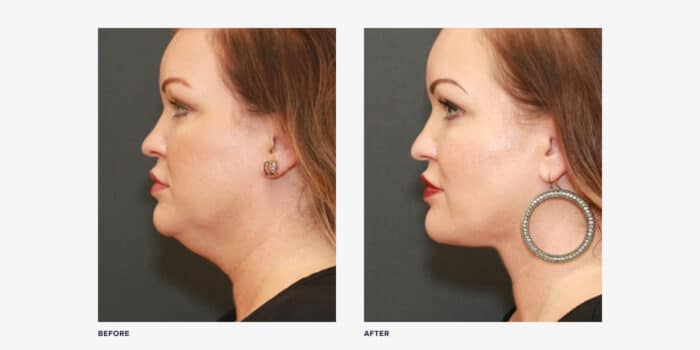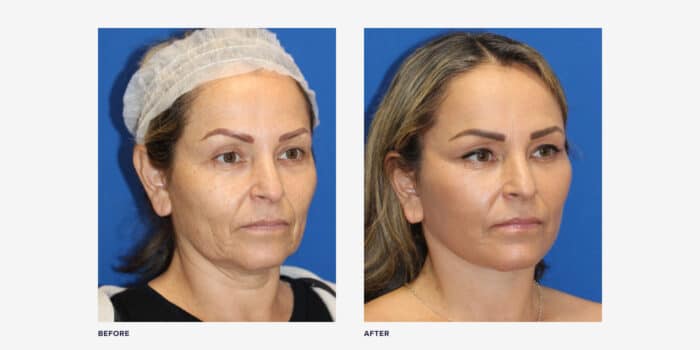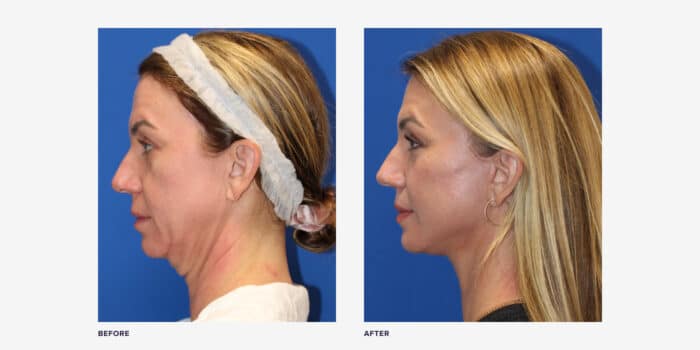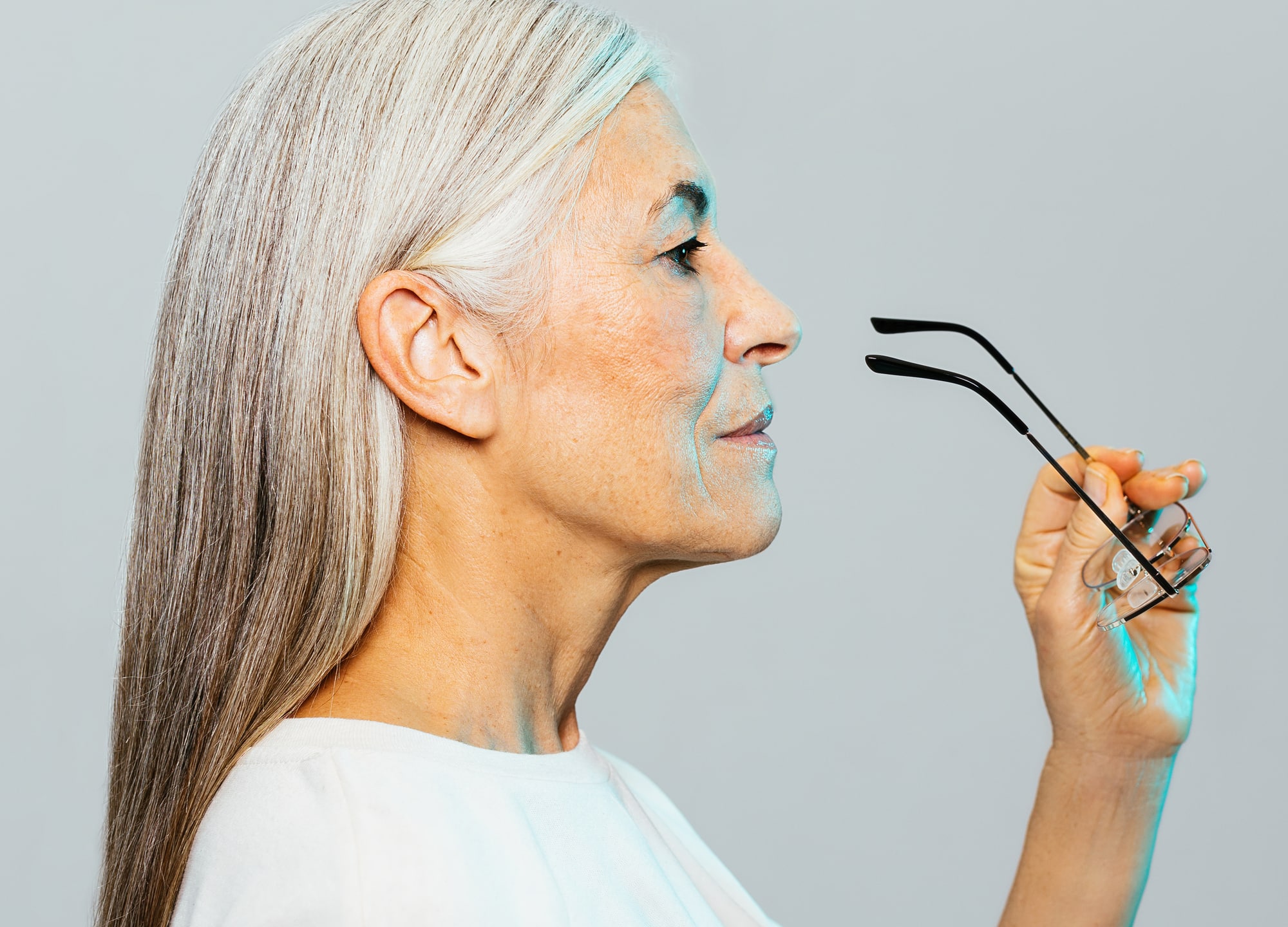There are few physical features that are as elegant as a swanlike neck—and in the case of one that’s sagging or undefined, the solution (beyond a scarf) is a neck lift. As Nora Ephron famously opined, “you can put makeup on your face and concealer under your eyes and dye on your hair, you can shoot collagen and Botox and Restylane into your wrinkles and creases, but short of surgery, there’s not a damn thing you can do about a neck.”
In younger patients, neck lifts are often used to address fat in the submental area, which can cause a patient to look heavier and more mature than they are. More mature patients benefit from tightening of the muscles and skin below the jaw, correcting the look of jowls while restoring lost contours.
If these characteristics apply to you—and you’ve started researching the possibilities of a future procedure—then you’re likely reviewing neck lift before and after photos. If you’re new to this, you might not know what to look for in quality B&As. While a bad facelift result is pretty obvious (a patient’s face can look tight and almost windswept), signs of a poorly done neck lift may not be as clear. Here, with the help of board-certified plastic surgeons, we break down the essential before-and-after aspects that exemplify a fantastic neck lift.
1. Visible shadow below the chin and natural neck movement
Spend enough time on social media—even if it’s just looking at makeup tutorials—and you’ll get a sense of all the unique ways that photography can trick the eye. Beyond the obvious ways to alter an image (like editing and filters), a critical aspect of photography is the lighting, which can enhance or diminish the results of a neck lift. An ultra-bright, blown out photo won’t show shadows beneath the chin, while dimmer photos might look more sculpted. You’ll want to ensure that the lighting is similar across the before and after shots, to know you’re seeing an accurate representation of the results.
You’ll also want to look closely at the subject’s proportions in both images, to ensure they’re similar. Disparities could signal the use of a different camera or lens, says Dr. L. Mike Nayak, board-certified plastic surgeon in St. Louis. He notes that you can figure out if different lenses were used for before and after shots by comparing the size and shape of the patient’s skull. “A neck lift isn’t going to change the shape of your skull,” he points out. “If the skull is a dramatically different shape and size, you could suspect a different focal length,” which controls the viewing angle and magnification of an image. A shorter lens and closer shot will make a face appear longer and narrower, making it complicated to determine whether a neck has genuinely slimmed down from surgery.
When looking at neck lift B&As, be mindful of the facial expressions in each image. A scowl in the former with a grin in the latter is not a great sign. “You can’t put up a before picture of the patient not smiling with the after picture of them smiling,” explains Dr. Nayak. “When you smile, it takes slack up into your cheeks and it looks better under your chin.” Similarly, the patient’s chin shouldn’t be tipped up but level or down: If the patient’s head is tilted upward, it will naturally make their chin and neck appear more sculpted, while looking straight forward or down will better show the folds beneath their jowls—or lack thereof.

Lastly (and perhaps obviously), the direction the patient is facing in the photos should match. If they’re taken from the side before surgery, they shouldn’t be taken head-on post-op. “For the neck, specifically, you’ve got to see the profile view—it’s the most telling,” says Dr. Amir Karam, board-certified plastic surgeon in San Diego. “The front view is nice too, but the action is really happening on the side view.” From the side, you’ll best be able to see the contours of the patient’s neck (more on this shortly).
One of the easiest ways to tell if a neck lift patient’s results look natural is through video. Over time, Dr. Nayak has opted to post more and more B&As with videos, as they can provide the most accurate representations of an outcome. Look for people with normal movement, he says. “Do they look warm, friendly, and healthy, or do they look tight, strained, and uncomfortable?”
It’s important to remember that discrepancies between befores and afters are not necessarily an indicator of dishonesty. A provider could just be bad at photography! But don’t just look at the images individually—consider them as a whole. If they’re oddly lit, strangely proportioned, and generally inconsistent, the seemingly impressive after images may be concealing poor results.
2. Sculpted yet gentle definition of the neck and jaw
You know what they say—great plastic surgery is invisible. “With neck lifts, you can make incredibly dramatic differences, but if the [results] look normal, no one notices,” says Dr. Nayak. A pretty neck lift outcome will transform the patient’s neck from full and/or lax to angular, with a shadow that goes as far back along the jaw and toward the ear as possible. And while it’ll look sharper than it once did, there should also be a softness—like a “blanket of snow” on top of the new edges, Dr. Nayak says.
You also should be able to see a sculpted jaw, not just a taut neck. That’s why Dr. Karam typically couples his neck lifts with lower or full facelifts—his signature procedure, Vertical Restore, combines all these and more—for the most natural-looking results. It is rare that he treats a patient that solely needs a neck lift. “If you’re young and have tight muscles, you can just do a neck lift,” he says. “If you’re older and you have loose muscles, a neck lift by itself isn’t going to be the answer.”

There’s a reason for this: As we age, everything starts to sag, but many people first notice laxity in their neck. “Having a contoured, firm-looking neck is synonymous with youth and beauty,” explains Dr. Karam. However, if a patient who is experiencing jowling opts just for a neck lift, it’ll be quite obvious that they got work done: While they will have a youthful-looking neck for a few years, their face will look older. Worse, as the facial tissue continues to sag, it will cause a domino effect, making the skin of the neck fall and shortening the life span of the lift.
Ultimately, what it comes down to is looking for a result so realistic that if you passed someone on the street with a good neck lift, you’d think they were born that way. Those with a bad neck lift might make you do a double take, either IRL or midscroll on Instagram.
3. No “casualties” on the rest of your face
Don’t think that visible incisions are necessarily indicative of poor work. “If you see an incision line up to six months after surgery, that’s normal,” says Dr. Nayak. “They heal over several months.” Rather, it’s the placement of the incisions and subsequent scarring that can signal surgery. Incisions should be tucked into contours and creases, like under the jaw or behind the ear—never up the temple, where it’ll always be on display. (This is a common hallmark of a bad facelift.)

While a bad scar is never ideal, it can always be hidden with makeup (or long hair, in some cases!), but there are other aspects of surgery to look for in a bad after photo that can’t be masked. Dr. Karam calls out the “pixie ear,” when a patient’s earlobe no longer looks distinct but appears to grow out of their neck or jawline. Another applies to men: When the skin is pulled back and up, a beard will be displaced, changing the pattern of the facial hair growth and necessitating shaving behind the ear, explains Dr. Karam. If the procedure was combined with a lower facelift, some patients could even see hair growth on the tragus, the small piece of cartilage in front of the ear canal. To some degree, displaced hair growth is unavoidable — but even to an untrained eye, it will be very obvious when overdone.
4. Long-term results
In general, it can be hard to find B&As taken more than several months after surgery, largely because it’s impractical, especially if you’re researching a provider who frequently operates on patients from out of town. “In an ideal world, I would bring all my patients back [for photos] at six months and 12 months later—or they would all take time out of their busy lives to send me photos every few months,” says Dr. Nayak. It’s at this point in the recovery process that you’ll see a stable and accurate outcome.
That’s not to say that you won’t be able to glean an understanding of what kind of work a provider offers if the photo is taken sooner than a year post-op. But recovery takes longer than you might think: “To some degree, there’s going to be swelling in the neck for up to six months,” says Dr. Karam. “If you only have a one-month photo to look at, that’s where things can get a little dicey.”











